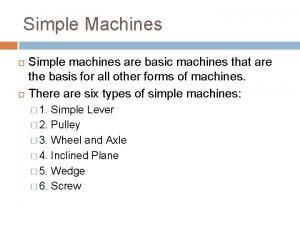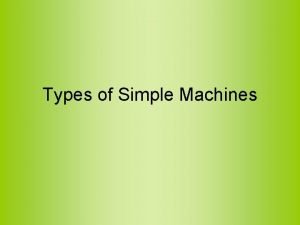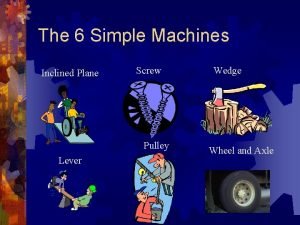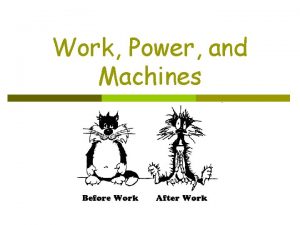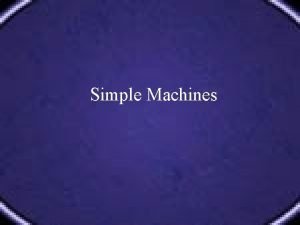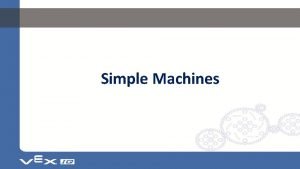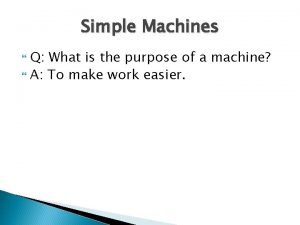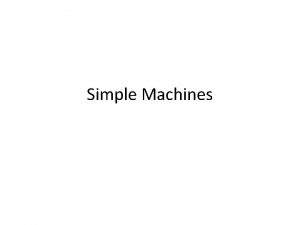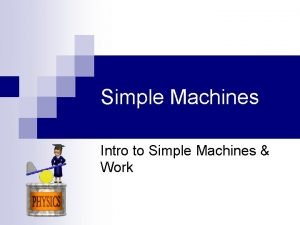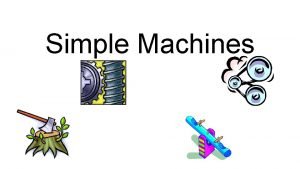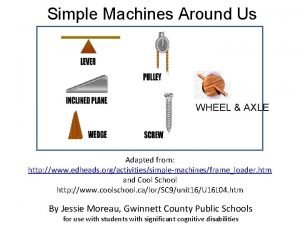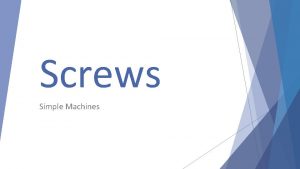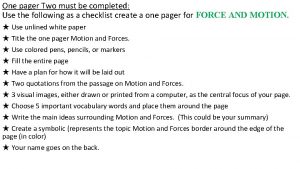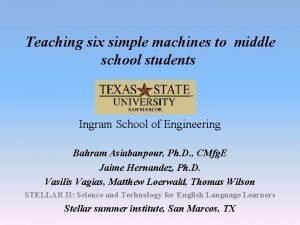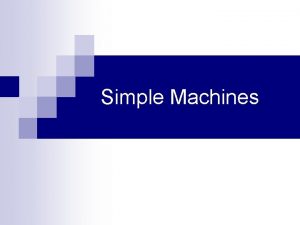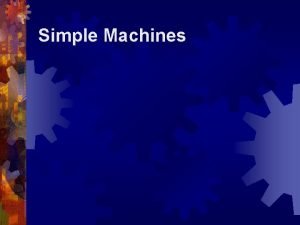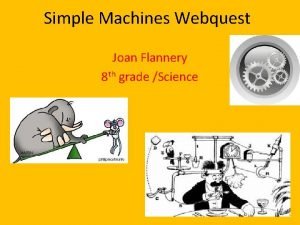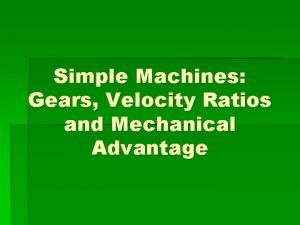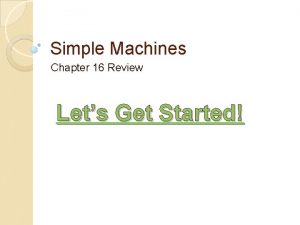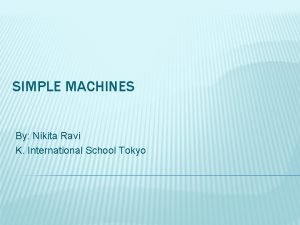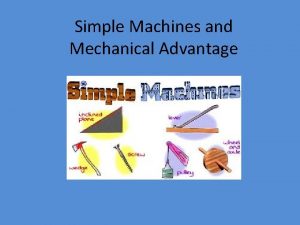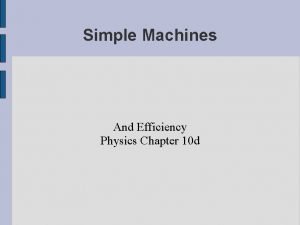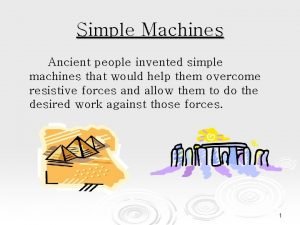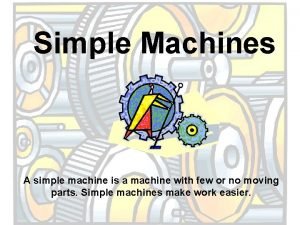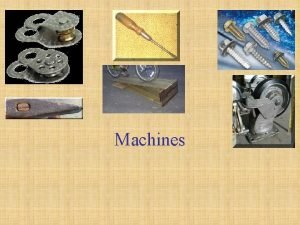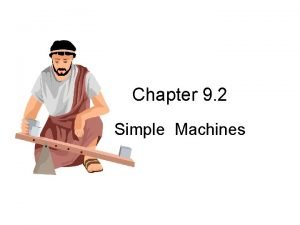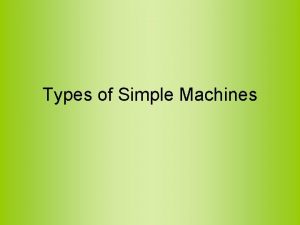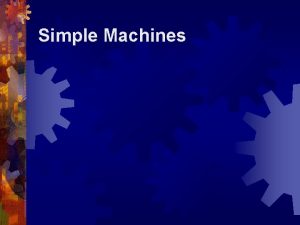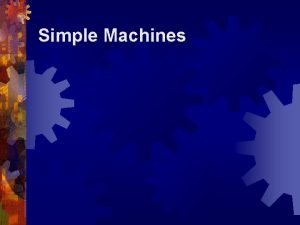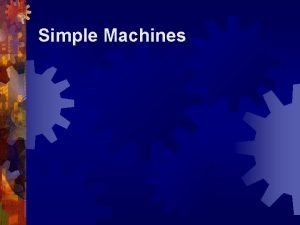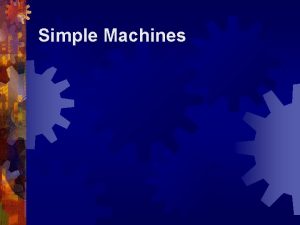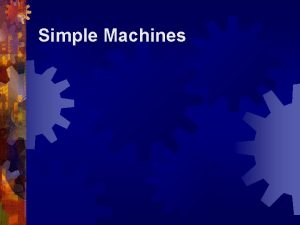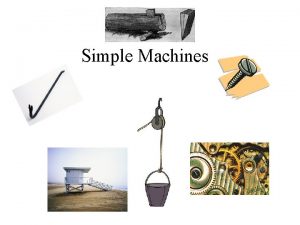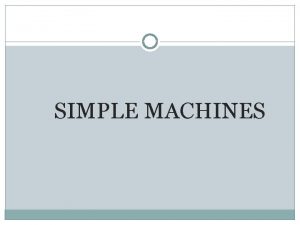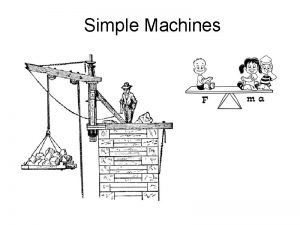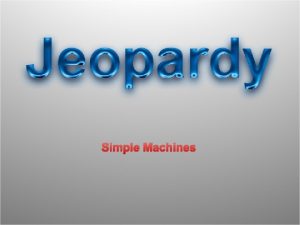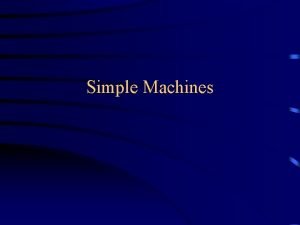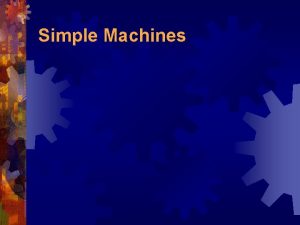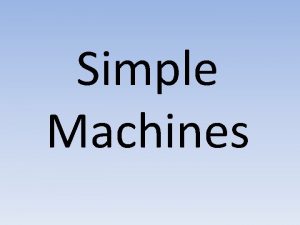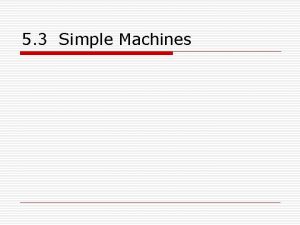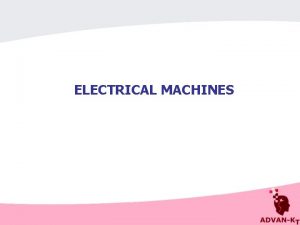Types of Simple Machines The Lever The Lever




































- Slides: 36

Types of Simple Machines

The Lever

The Lever

The Pulley

The Pulley • A pulley changes the direction of the force: – Instead of lifting up, you can pull down using your body weigh against the load (what is being lifted) • A pulley gains nothing in force, distance or speed

The Inclined Plane

The Inclined Plane a sloping surface that does not move • An inclined plane provides for NOT Less work but less effort. • The trade off is greater distance to travel.

The Screw

The Screw an inclined plane wrapped around a central cylinder • A Screw has two (2) parts: – The Body – Cylinder Post – The Thread – Inclined Plane wrapped around the cylinder.

The Wedge

The Wedge an inclined plane that tapers to a sharp edge • The wedge used to increase force. • The material remains in place while he wedge moves through it. • A wedge changes the direction of the input force.

The Wheel & Axle

The Wheel & Axle a wheel connected to a rigid pole • The Wheel & axle is a modified lever: – The center of the axle acts as a fulcrum – making the wheel a lever that rotates around in a circle.

Work • Work happens when a force moves an object over a distance. • If the object does not move, NO work is done!

The Lever a rigid bar that is free to turn about a fixed point called the fulcrum Every Lever has three (3) parts: 1. Resistance Force, Input Force or Load, What you are trying to move or lift. 2. Effort Force or Output Force - The work done on the Lever. 3. Fulcrum – A fixed pivot point.

1 st Class Lever

1 st Class Lever • The Fulcrum (fixed pivot point) is located between the Effort (Input) and the Resistance (Output) Forces. • The effort and the resistance move in opposite directions. • The effort force pushes down in order to lift the resistance or load.

1 st Class Lever • When the fulcrum is closer to the effort than to the load: – there is a loss in force – There is a gain in speed and distance.

1 st Class Lever • When the fulcrum is closer to the load than to the effort: – there is a loss in speed and distance – There is a gain in force.

1 st Class Lever • When the fulcrum is midway between the effort and the load: – there is no change in force, speed or distance

1 st Class Lever • Examples: – Seesaw – Crowbar – Scissors

2 nd Class Levers

2 nd Class Lever • The load is between the effort and the fulcrum. • The fulcrum is at one end of the lever. • The fulcrum is usually closer to the load. • Produce a gain in force.

2 nd Class Levers • Examples: – Wheelbarrow – Bottle opener – Nutcrackers

3 rd Class Levers

3 rd Class Levers • The effort is between the load and the fulcrum. • There is usually a loss in force, but a gain in speed and distance.

3 rd Class Levers • Examples: – Broom – Shovel – Fishing rod

The Pulley a wheel that turns around an axle • A pulley is a grooved wheel that turns around an axle (fulcrum), and a rope or a chain is used in the grove to lift heavy objects. • A pulley may be fixed, moveable, or used in combination.

The Fixed Pulley • Is attached to something that doesn't move such as the ceiling or wall) • It acts as a first class lever with the fulcrum located at the axis • Instead of a bar the pulley uses a rope or chain.

The Pulley • A moveable pulley acts as second class lever – the load is between the fulcrum and the effort

The Pulley • A compound pulley is a system of movable pulleys. • Mechanical advantage can be increased by using more than one pulley.

The Inclined Plane • Used to reduce the force needed to overcome the force of gravity when lifting or lowering a heavy object.

The Inclined Plane

The Screw • Functions of the screw – To fasten things – the standard screw or nuts & bolts. – Drill bits are screws used to make holes. – A jackscrew is used to lift heavy objects; car jack.

The Screw • When you turn a screw: – The input force is changed by the threads into an output force. – The output force pulls the screw into the materials. – Friction between the threads & the material holds the screw in place.

The Wedge • Wedges can be forced between two things to hold them tightly together, like nails or a doorstop. • Wedges can be used to split, cut or fasten.
 Lever family simple machines
Lever family simple machines What is simple machine lever
What is simple machine lever Examples of third class lever machines
Examples of third class lever machines 6 types of simple machines examples
6 types of simple machines examples What type of simple machine is a lawn mower
What type of simple machine is a lawn mower 6 simple tools
6 simple tools A stiff bar that rests on a support
A stiff bar that rests on a support What is the purpose of a machine
What is the purpose of a machine Identify the simple machine
Identify the simple machine What are the six types of simple machines
What are the six types of simple machines Types of simple machines
Types of simple machines Wheel and axle simple machines
Wheel and axle simple machines What is used to hold things together
What is used to hold things together Pulley system
Pulley system Force and motion one pager
Force and motion one pager Types of simple machines
Types of simple machines Examples of wedge simple machines
Examples of wedge simple machines Poster slogan example
Poster slogan example Simple machines mikids
Simple machines mikids Slide to doc.com
Slide to doc.com What simple machines are in a bike
What simple machines are in a bike Conclusion of simple machine
Conclusion of simple machine Simple machines study guide
Simple machines study guide Simple machine
Simple machine Simple machine window blinds
Simple machine window blinds Formula of velocity ratio
Formula of velocity ratio Classification of simple machine
Classification of simple machine Which simple machine is scissors
Which simple machine is scissors A simple machine that is a flat, sloped surface
A simple machine that is a flat, sloped surface Efficiency of simple machines
Efficiency of simple machines Who invented simple machines
Who invented simple machines Simple machine examples
Simple machine examples An inclined plane wrapped around a rod
An inclined plane wrapped around a rod Simple machines kitchen
Simple machines kitchen Compound machine with 3 simple machines
Compound machine with 3 simple machines Ancient simple machines
Ancient simple machines Differentiate between simple machine and compound machine
Differentiate between simple machine and compound machine
